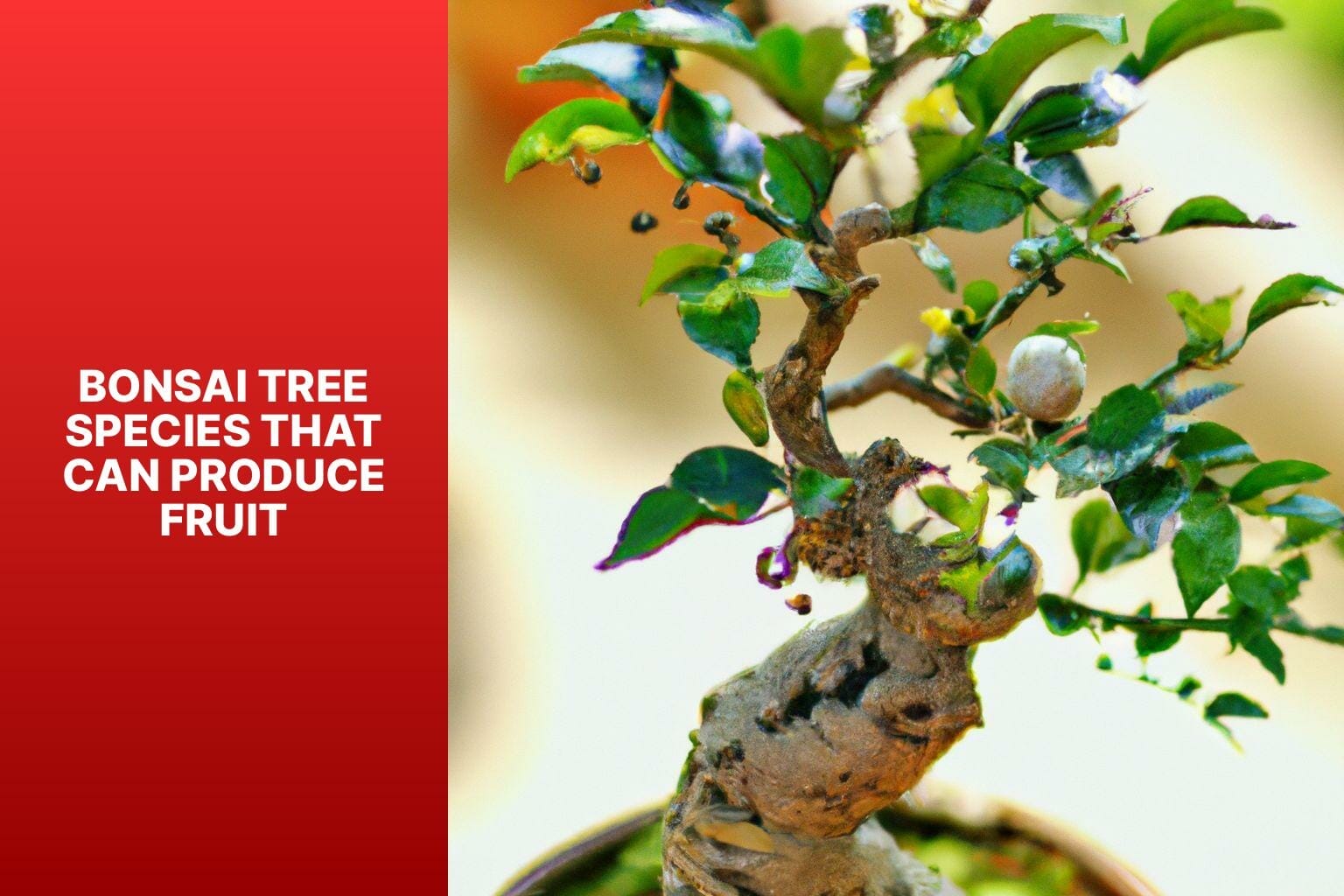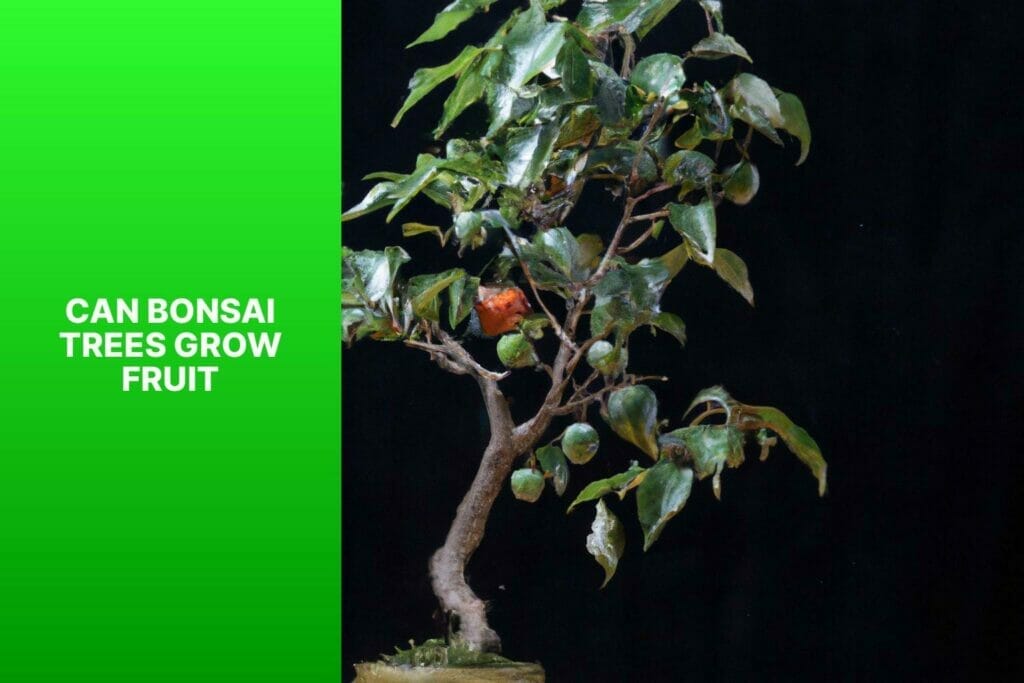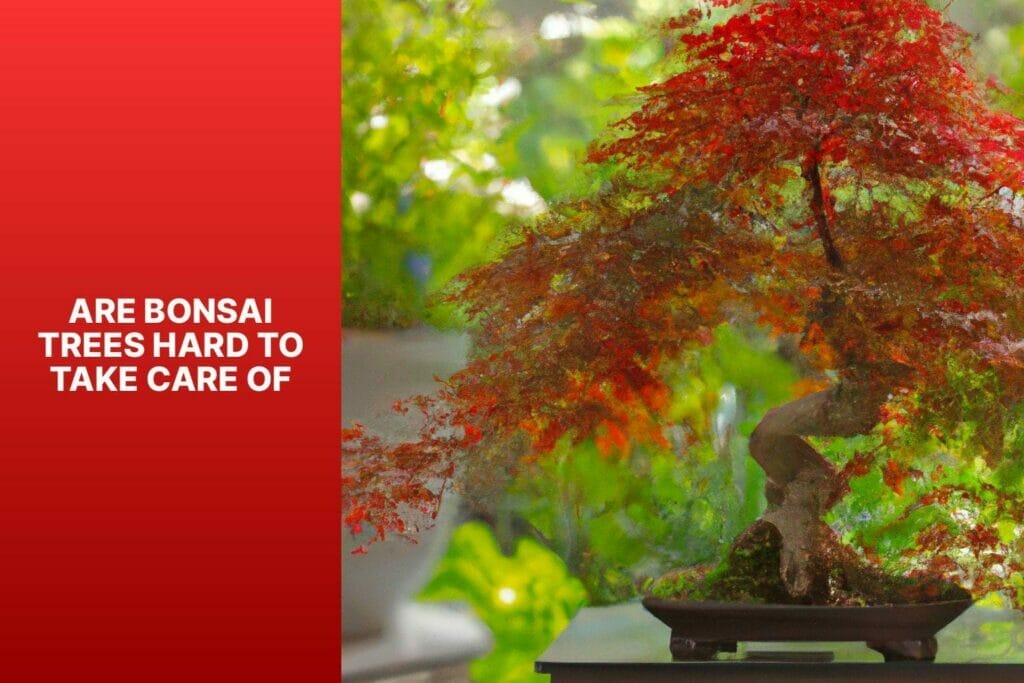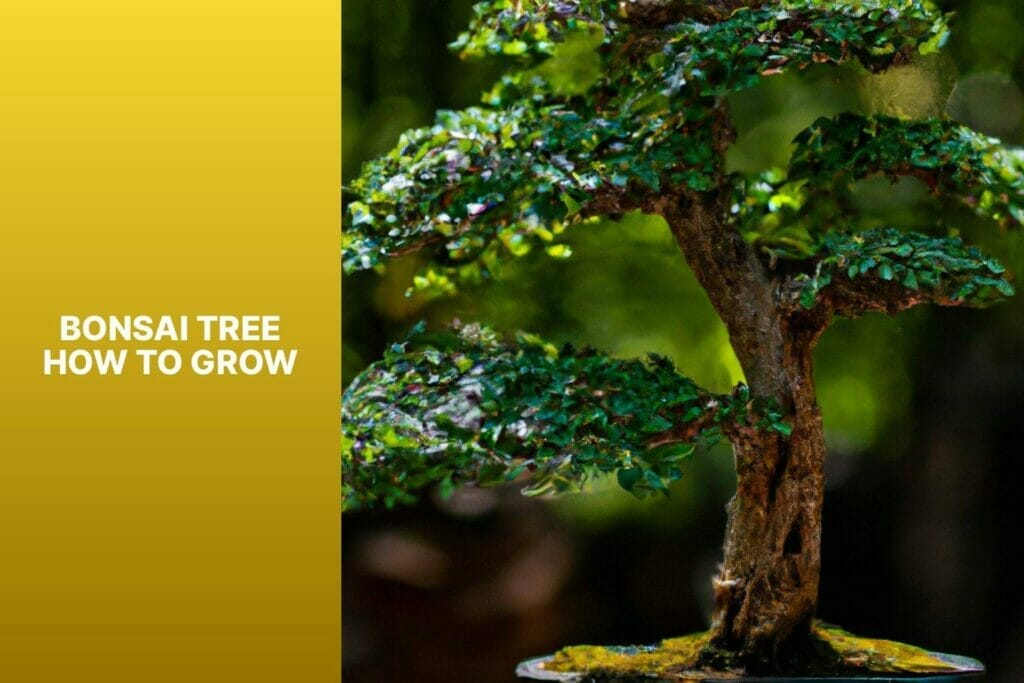Bonsai trees have captivated the interest and admiration of people worldwide with their miniature size and intricate beauty. While bonsai trees are commonly known for their aesthetic appeal, one might wonder if these unique trees can bear fruit.
This article will explore the bonsai tree world and the possibility of fruiting these miniature marvels.
It is essential to understand whether bonsai trees can grow fruit at all. The answer to this question is not a simple ‘yes’ or ‘no.’
Several factors come into play regarding fruit growth in bonsai trees, including the tree species, the Age of the tree, and the care and maintenance provided.
Next, we will explore the factors affecting fruit growth in bonsai trees. We will discuss the importance of tree species, as certain species are better suited for fruit production than others.
The Age of the tree plays a crucial role, as younger trees are likelier to bear fruit than older trees. We will touch upon the significance of proper care and maintenance practices in promoting fruit growth in bonsai trees.
Moving forward, we will highlight some bonsai tree species that have the potential to produce fruit. Citrus trees, pomegranate trees, and fig trees are among the species known to bear fruit when cultivated as bonsai trees.
We will explore these species’ unique characteristics and requirements for successful fruit production.
To conclude the article, we will provide useful tips for growing fruiting bonsai trees. These tips include selecting the right tree species, ensuring adequate sunlight exposure, employing proper pruning techniques, and implementing appropriate fertilization and watering practices.
By following these tips, enthusiasts can increase their chances of successfully growing fruiting bonsai trees, adding an extra dimension of beauty and fascination to their collection.
1. Bonsai trees have the potential to grow fruit: Bonsai trees can produce fruit if the appropriate conditions are provided.
2. Factors affecting fruit growth in bonsai trees: The tree species, Age of the tree, and proper care and maintenance all play a role in determining whether a bonsai tree will bear fruit.
3. Bonsai tree species that can produce fruit: Certain bonsai tree species, such as citrus trees, pomegranate trees, and fig trees, are known for their ability to produce fruit when cultivated as bonsai trees.
Understanding Bonsai Trees and Fruiting
Bonsai trees are small, carefully cultivated, and pruned miniature trees. Many people grow bonsai trees as a hobby. Not all bonsai trees can bear fruit, as most are bred and cultivated for their aesthetic qualities rather than their ability to produce fruit.
Certain fruit tree varieties, like citrus or apple trees, can be grown as bonsai and may produce fruit under the right conditions.
To bear fruit, a bonsai tree must be healthy and well-cared for. Proper watering, fertilizing, and adequate sunlight are essential for tree health and fruit production.
Some fruit trees have specific environmental requirements, such as a certain temperature range or a period of dormancy, for fruit production.
Suppose you want to grow a bonsai tree that can bear fruit; research and choose a fruit tree type suitable for bonsai cultivation. Consider the care requirements and environmental conditions needed for fruit production.
Seek advice from experienced bonsai growers or horticulturists to ensure optimal conditions for your bonsai tree’s fruiting potential.
Understanding the requirements and limitations of bonsai trees in fruiting will help you make informed decisions and enjoy these miniature trees‘ beauty in your garden or home.
Can Bonsai Trees Grow Fruit?
Yes, bonsai trees can grow fruit. While bonsai trees are small, they can produce fruit like full-sized trees. It is important to consider the following factors to achieve fruit production:
1. Tree Species: Certain species of bonsai trees, such as citrus, pomegranate, and fig trees, are more likely to bear fruit when properly cared for.
2. Age of the Tree: Bonsai trees require a certain amount of time to mature before they can begin producing fruit. This process typically takes a few years.
3. Care and Maintenance: Fruit production in bonsai trees heavily relies on proper care, which includes providing the right amount of sunlight, water, and nutrients. Pruning and fertilization also play significant roles in promoting fruit growth.
Factors Affecting Fruit Growth in Bonsai Trees
Regarding bonsai trees, several factors can influence their ability to bear fruit. This section will uncover the key elements affecting bonsai tree fruit growth.
We’ll take a closer look at the role of tree species, the impact of the tree’s Age, and the importance of proper care and maintenance.
By understanding these factors, we can better nurture our bonsai trees and enhance their potential to bear the fruits of our labor.
Tree Species
Tree species play a crucial role in the success of a bonsai. Selecting tree species that can thrive in a bonsai environment and bear fruit is important.
Several tree species are known for their exceptional fruiting capabilities. Citrus trees, including lemon, orange, and tangerine varieties, are highly popular. These trees produce fragrant blossoms and yield small, edible fruits.
Pomegranate trees are another excellent option, featuring vibrant flowers and decorative fruits that add visual interest to the bonsai.
These fruits are also edible. Fig trees are another remarkable choice for bonsai enthusiasts due to their unique and attractive foliage and ability to produce deliciously sweet fruits.
When deciding on a tree species for your fruiting bonsai, it is important to consider various factors. Climate, available space, and personal preferences should all be considered.
It is crucial to note that different species may require specific care techniques to ensure successful fruit growth. It is also worth mentioning that not all bonsai tree species have the ability to bear fruit.
With proper care, the right tree species, and suitable conditions, you can cultivate a beautiful and fruitful bonsai tree that will undoubtedly add a touch of interest to your bonsai collection.
Age of the Tree
The Age of the tree affects fruit growth in bonsai trees. As bonsai trees age, their root system becomes more mature and robust, supporting fruit production.
Age of the Tree
| Age of the Tree | Impact on Fruit Growth |
|---|---|
| Youthful (1-5 years) | During the early years, bonsai trees focus on establishing a strong foundation and building their structure. Fruit production is unlikely during this stage. |
| Middle Age (5-15 years) | As the bonsai tree matures, it develops an extensive root system and a well-branched structure, enabling fruit growth. |
| Older Age (15+ years) | Bonsai trees that are more advanced in Age have the greatest potential for fruit production. Their well-established roots and enhanced overall health and vigor promote fruitful results. |
Anecdote:
I cared for my bonsai tree for several years, nurturing it to maturity. As the tree grew older, its roots became dense, and its branches thick and sturdy. One summer, to my delight, the bonsai tree bore fruit for the first time.
The tiny fruits added beauty and charm to the tree. It was rewarding to witness the transformation of the bonsai tree, knowing that its Age played a crucial role in its newfound ability to produce fruit.
Care and Maintenance
Proper care and maintenance are crucial for the health and productivity of fruiting bonsai trees. When caring for your bonsai tree, there are several key factors to keep in mind:
– Regular watering: To maintain optimal moisture levels, it is important to water your bonsai tree consistently. Make sure the soil is moist, but avoid overwatering. The watering frequency may vary depending on the type of tree and the weather conditions.
– Adequate sunlight: Fruiting bonsai trees require sufficient sunlight for the development of fruits. Place your bonsai tree in a location that receives abundant sunlight throughout the day. You can also use artificial grow lights in case of insufficient natural light.
– Proper pruning: Pruning is crucial in maintaining your bonsai tree’s size, shape, and fruiting ability. Trim back any overgrown branches regularly and remove any dead or diseased parts. Pruning stimulates new growth and promotes fruit production.
– Healthy soil and fertilization: Using well-draining soil specifically formulated for bonsai trees is essential. Regularly fertilize your bonsai tree to provide the necessary nutrients for fruit production. Choose a balanced fertilizer with the appropriate nitrogen, phosphorus, and potassium (NPK) ratio suitable for your tree species.
– Pest and disease control: Monitoring your bonsai tree for any signs of pests or diseases is important. Regularly inspect the leaves and branches for any infestation or infection. Use organic or chemical treatments to control pests and diseases effectively.
By following these care and maintenance practices, you can ensure the proper growth and development of your fruiting bonsai trees.
Bonsai Tree Species That Can Produce Fruit

Photo Credits: Mnbonsainetwork.Com by Thomas Carter
Bonsai enthusiasts, get ready to discover a whole new dimension in the world of these miniature marvels. Today, we delve into the fascinating realm of bonsai tree species that bear fruit.
From vibrant citrus trees to the tantalizing pomegranate and the delicate fig, these sub-sections will take us on a journey through the fruitful wonders of the bonsai world.
So, buckle up and prepare to be amazed by the bountiful surprises that await us!
Citrus Trees
I once owned a bonsai citrus tree, specifically a lemon tree. Citrus trees, including lemon trees, require certain care requirements to thrive.
They need full sun, well-draining soil, regular watering, and occasional fertilization. The lemon fruits had the signature sour taste of regular-sized lemons. It was fascinating to witness nature’s wonders in such a small plant.
The citrus fragrance filled the room whenever I walked by the bonsai, bringing joy and satisfaction. Having a citrus bonsai tree added beauty to my home and allowed me to enjoy fresh citrus fruits from the comfort of my living room.
Pomegranate Trees
Pomegranate trees are widely known for their vibrant fruits and attractive leaves, making them popular for growing fruiting bonsai.
These trees belong to the Punica genus and can be found in regions like the Middle East and South Asia. When cultivated as bonsai, pomegranate trees can produce small, edible fruits like regular pomegranates.
To successfully grow pomegranate bonsai, certain factors need to be considered. First and foremost, it is important to choose suitable tree species, such as dwarf or miniature pomegranate varieties, as they are better suited for bonsai.
Another crucial aspect of pomegranate bonsai’s growth and fruit production is adequate sunlight. These trees thrive in full sun and require a minimum of 6-8 hours of direct sunlight daily.
Proper pruning is important in maintaining the bonsai tree’s desired size and shape while promoting healthy fruit growth.
Appropriate fertilization and watering are essential for nourishing pomegranate bonsai. A balanced fertilizer with a higher potassium content is recommended, as this helps stimulate fruit production.
Regular watering is necessary to keep the soil moist without causing waterlogging.
Pomegranate trees have a long and rich history that dates back thousands of years. They have been mentioned in ancient texts from various civilizations, including Greek, Roman, and Persian mythology.
The pomegranate symbolizes fertility, abundance, and prosperity in many cultures. In today’s world, pomegranates are highly celebrated for their unique taste and numerous health benefits.
As a result, the cultivation and enjoyment of pomegranate trees as bonsai continue to thrive.
Fig Trees
Fig trees are popular for bonsai enthusiasts due to their unique fruit and beautiful foliage. Several species of fig trees can be grown as bonsai, including Ficus carica, Ficus benjamina, and Ficus religiosa.
These trees are resilient and adaptable to different environments.
Give them 6-8 hours of sunlight daily and regular watering to care for fig trees. Pruning techniques like pinching back branches and thinning out excess growth help maintain the desired shape and size of the fig tree bonsai.
Regular pruning also stimulates new growth and enhances fruit production.
Fertilization is crucial for fig trees, and using a balanced fertilizer with higher potassium content encourages healthy fruit development. Fertilize the tree every 4-6 weeks during the growing season.
Fig trees can produce a significant amount of fruit, but the quantity may vary depending on species, tree age, and care provided.
Patience, consistent care, and the right growing conditions are key to successful fruit development.
Tips for Growing Fruiting Bonsai Trees
Growing bonsai trees that bear fruits is fascinating but requires knowledge and attention to detail. This section will uncover valuable tips to help you cultivate fruiting bonsai trees.
From selecting the right species to ensuring adequate sunlight, proper pruning techniques, and appropriate fertilization and watering, we will explore the essential factors that contribute to the fruitful growth of these miniature natural wonders.
Get ready to delve into the world of fruiting bonsai trees and unlock the secrets to their bountiful beauty.
Choosing the Right Species
When growing fruiting bonsai trees, selecting the right species is crucial for success. Each species has specific requirements and characteristics that affect fruit production. Consider the following factors when choosing a species:
– Varieties:
There are several fruiting bonsai tree species available, including:
– Citrus Trees
– Pomegranate Trees
– Fig Trees
– Growth Habits:
Consider the growth habits of different species. Some species, like citrus trees, have dwarf varieties better suited for bonsai cultivation.
Others, like fig trees, naturally have smaller leaves and compact growth, making them ideal for bonsai. Choose a species with growth habits that can be easily manipulated and maintained in a bonsai form.
– Climate:
Ensure the chosen species is suitable for your climate. Some fruiting bonsai tree species require specific temperature ranges and conditions to thrive and produce fruit. Research the climate requirements of each species and choose one that will thrive in your area.
– Personal Preference:
Consider your personal preferences for fruits and aesthetics. Choose a species that produces fruits you enjoy and looks visually appealing as a bonsai tree.
Providing Adequate Sunlight
Providing Adequate Sunlight is crucial for the growth of fruiting bonsai trees. Sunlight is vital for photosynthesis, which produces energy and nutrients for fruit development.
To ensure your bonsai trees get enough sunlight, follow these steps:
1. Placement: Choose a sunny location for your bonsai trees. They should receive at least 6 hours of direct sunlight daily.
2. Orientation: Position your bonsai trees to maximize sunlight exposure. For instance, if you live in the Northern Hemisphere, place them facing south for maximum sunlight.
3. Monitor shade: Regularly check for objects or structures that cast shade on your trees. Remove any obstructions to allow sufficient sunlight.
4. Rotate: It is important to regularly rotate your bonsai trees to ensure that all parts receive equal sunlight. This promotes even growth and fruit production.
Pro-tip: If you lack direct sunlight, consider using artificial grow lights specifically designed for plants. These lights provide the necessary light spectrum for photosynthesis and can be an excellent alternative for indoor bonsai tree cultivation.
Providing Adequate Sunlight enhances the health of your fruiting bonsai trees and increases the chances of a successful fruit harvest. Remember to monitor sunlight levels, adjust the positioning as needed, and enjoy the beauty of thriving bonsai trees.
Proper Pruning Techniques
When growing fruiting bonsai trees, proper pruning is essential for health and optimal fruit production. Follow these steps:
1. Remove dead or diseased branches to maintain tree health and prevent disease spread.
2. Identify and selectively prune crossed or rubbing branches that hinder air circulation and may cause damage or weak spots.
3. Thin out branches to allow more light to reach the inner parts of the tree, promoting even growth and fruit production.
4. Use “apical pruning” to promote branching and stimulate fruiting by trimming the topmost buds or branches to redirect energy towards lower branches.
5. Continuously monitor tree growth throughout the season and prune as needed to maintain desired shape and size and prevent overgrowth.
Proper pruning shapes bonsai trees and encourages fruit development. You can cultivate visually appealing bonsai trees with delicious fruits by following these steps.
Bonsai originated in China over a thousand years ago and later spread to Japan. Initially, bonsai trees were grown for aesthetics, but growers discovered some bonsai tree species could produce fruit.
This led to the development specific techniques, including proper pruning, to enhance fruit production in bonsai trees. Today, enthusiasts value fruiting bonsai trees for their unique beauty and practicality.
When growing fruiting bonsai trees, proper pruning is essential for health and optimal fruit production. Follow these steps:
1. Remove dead or diseased branches to maintain tree health and prevent disease spread.
2. Identify and selectively prune crossed or rubbing branches that hinder air circulation and may cause damage or weak spots.
3. Thin out branches to allow more light to reach the inner parts of the tree, promoting even growth and fruit production.
4. Use “apical pruning” to promote branching and stimulate fruiting by trimming the topmost buds or branches to redirect energy towards lower branches.
5. Continuously monitor tree growth throughout the season and prune as needed to maintain desired shape and size and prevent overgrowth.
Proper pruning shapes bonsai trees and encourages fruit development. You can cultivate visually appealing bonsai trees with delicious fruits by following these steps.
Bonsai originated in China over a thousand years ago and later spread to Japan. Initially, bonsai trees were grown for aesthetics, but growers discovered some bonsai tree species could produce fruit.
This led to the development specific techniques, including proper pruning, to enhance fruit production in bonsai trees. Today, enthusiasts value fruiting bonsai trees for their unique beauty and practicality.
Appropriate Fertilization and Watering
Appropriate fertilization and watering are vital for bonsai trees’ healthy growth and fruit production. Choosing the right fertilizer specifically designed for bonsai trees is important, with a nitrogen-phosphorus-potassium (NPK) ratio of 10-10-10 or 14-14-14.
During the growing season, fertilize the bonsai tree every two to four weeks, following the instructions on the fertilizer packaging for the correct dosage.
Watering is also crucial in ensuring the roots receive enough moisture. Water the bonsai tree until water drains from the pot’s drainage holes. Watering frequency depends on tree species, pot size, and environmental conditions.
To check soil moisture, insert a finger into the soil; if it feels dry, it is time to water the tree. Overwatering should be avoided as it can lead to root rot and other issues. Use well-draining soil and remove excess water from the pot’s saucer or tray.
When watering, it is best to use rainwater or filtered water to avoid tap water with high chlorine or chemical levels.
Pay attention to the tree’s response to the fertilization and watering routine. Adjust fertilization and watering accordingly if you notice leaves turning yellow or the soil becoming excessively dry or soggy.
Some Facts About Can Bonsai Trees Grow Fruit:
- ✅ Bonsai trees are not genetic dwarf trees but full-size trees maintained in miniature through pruning.
- ✅ Certain bonsai trees can produce edible fruit, as they are just pruned and trained versions of full-size trees.
- ✅ The fruit produced by a bonsai tree will be normal-sized, not miniature.
- ✅ The fruit from a bonsai tree is edible and tastes like fruit from a full-size tree.
- ✅ Popular bonsai fruit trees include crab apple, citrus, fig, berries, olive, and pomegranate.


